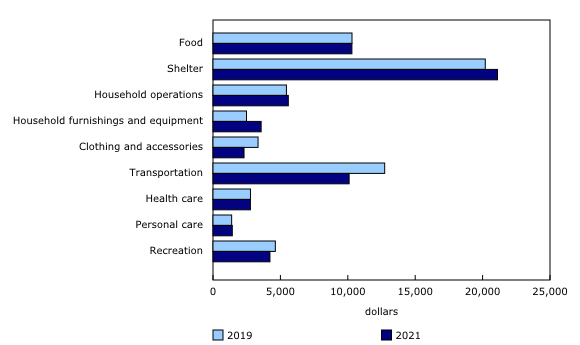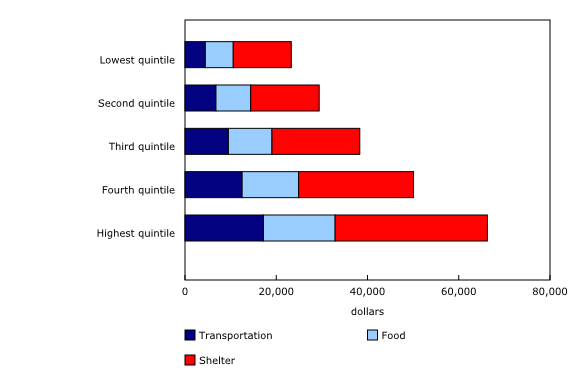Survey of Household Spending, 2021
Released: 2023-10-18
$67,126
2021
Canadian households spent an average of $67,126 on goods and services in 2021, down 2.7% from 2019. This was the first decline in household spending since 2010. Accounting for consumer inflation (+4.1%) from 2019 to 2021, the real decrease in average household spending was 6.5%.
On average, Canadian households spent less in various spending categories during the COVID-19 pandemic, which contributed to the decline in total consumption of goods and services from 2019 to 2021.
Shelter (31.4%), food (15.4%) and transportation (15.0%) remained the three largest spending categories in 2021.
Household spending on transportation fell amid the pandemic
In 2021, Canadian households spent an average of $10,099 on transportation, down 20.7% from 2019. Of this total, $9,501 was spent on private transportation, down 15.6% from 2019. Average spending on purchase of automobiles, vans and trucks ($4,083) in 2021 dropped by 16.7% from 2019. Although the average gasoline price increased by 12.8% from 2019 to 2021, average spending on gasoline and other fuels ($2,080) decreased by 14.1%.
Average household spending on public transportation was $598 in 2021, down 59.6% from 2019. The decrease was seen in all provinces, ranging from a decrease of 52.5% in New Brunswick to a decrease of 70.6% in Saskatchewan. The largest contributor to the decrease was spending on air travel, for which Canadian household spending fell from an average of $871 in 2019 to $230 in 2021. The reduction in average expenditure for air travel was consistent with a large decline in the number of airplane passengers from 2019 to 2021.
Households spent substantially less, on average, for recreational services, clothing and accessories, child care, and food from restaurants
In 2021, households spent an average of $4,223 on recreation, down 8.7% from 2019, primarily driven by a decrease in spending on recreational services (-55.0%), such as movie theatres, live sporting and performing arts events, and package trips. From 2019 to 2021, average spending on clothing and accessories ($2,303) dropped by 31.1%, and average spending on child care ($371) fell by 42.7%.
During 2021, as a result of the pandemic, many restaurants were restricted to delivery services, takeout or to work under full capacity, which was reflected by lower household average spending on food from restaurants ($2,189), down 21.1% from 2019. In contrast, spending on food from stores ($8,065) increased by 7.0% in 2021.
Homeowners with mortgage payments and renters spent more on shelter in 2021
In 2021, Canadian households spent an average of $21,106 on shelter, up 4.5% from 2019. The increase was explained by higher average shelter expenditures among both homeowners with a mortgage and renters. Homeowners with a mortgage reported an average of $33,118 spent on shelter in 2021, up 7.8% from 2019. Mortgage payments ($18,507) accounted for more than half of this total and increased by 9.1% from 2019. Additionally, more households were homeowners in 2021 (69.3%) compared with 2019 (66.8%), with more than half of homeowners having a mortgage, which also contributed to higher total spending on shelter among Canadian households. Renters spent an average of $15,256 on shelter in 2021, up 5.9% from 2019. Of this total, $13,060 went to rent, up 6.8% from 2019.
Canadian households spent more on household furnishings and equipment and on communications during the pandemic
In 2021, Canadian households reported spending an average of $3,570 on household furnishings and equipment, up 43.6% from 2019, partially reflecting higher demand for home renovations and the strength of the housing market observed in 2021.
Average household spending on communications was $3,001 in 2021, up 12.4% from 2019. This increase was driven by higher expenditures for the purchase of telephones and equipment (+114.1%), Internet access services (+21.7%), digital services (+30.5%), and postal, courier, delivery and other communication services (+68.7%).
Spending patterns varied among the provinces
Among the provinces, households in British Columbia ($75,028) and Alberta ($75,003) reported the highest average spending on goods and services in 2021, while households in New Brunswick ($57,582) and Quebec ($57,889) reported the lowest average spending.
On average, households in British Columbia ($24,594) and Ontario ($24,101) spent the most on shelter in 2021, while households in New Brunswick ($14,685) and Newfoundland and Labrador ($14,736) spent the least. Households in Ontario allocated the largest share of total consumption to shelter (34.6%) among the provinces, while households in Newfoundland and Labrador spent the smallest share (24.4%). From 2019 to 2021, average spending on shelter rose the most in Prince Edward Island (+10.7%), followed by Ontario (+7.8%).
Households in Manitoba ($11,230) and Alberta ($11,066) reported the highest average spending on transportation among the provinces in 2021, while households in Quebec ($9,409) reported the lowest. This was largely because households in Manitoba ($10,798) and Alberta ($10,438) spent the most on private transportation, while households in Quebec ($8,979) spent the least. For public transportation, households in British Columbia ($751) and Ontario ($724) reported the highest average expenditure, while households in New Brunswick ($277) reported the lowest.
Compared with 2019, all provinces saw an increase in average spending on communications in 2021, ranging from an increase of 7.0% in British Columbia to an increase of 22.3% in Manitoba. Average spending on communications was highest in Alberta ($3,456) and lowest in Quebec ($2,342). This was partially due to households in Alberta ($1,592) reporting higher spending on cell phone and pager services than those in Quebec ($972).
In 2021, average spending on tobacco products, alcoholic beverages and cannabis for non-medical use was highest in Saskatchewan ($2,278) and lowest in Ontario ($1,530).
Household expenditures varied by income
Higher income is generally associated with higher spending. Distributing the population into five equal income groups, or quintiles, allows for a comparison of spending between different household income levels. In 2021, the 20% of Canadian households with the lowest incomes spent an average of $36,376 on goods and services, compared with an average of $109,752 for those in the top 20% of household incomes.
While households in the lowest income quintile spent an average of $6,129 on food, and those in the highest spent an average of $15,715, the difference in the shares of their total consumption allocated to food was relatively small: 16.8% for the lowest income quintile versus 14.3% for the highest quintile.
Household spending on transportation also varied by income. On average, households in the lowest income quintile spent $4,449 on transportation (12.2% of their total consumption of goods and services) in 2021. In contrast, the highest income quintile households spent $17,190 (15.7% of their consumption).
One-person households allocated a larger share of spending to shelter
In 2021, one-person households ($38,330) reported the lowest average spending on goods and services, followed by lone-parent households ($63,881), a pattern which has been observed since it was first measured in 2010. In comparison, couples with children ($96,019) spent, on average, $31,148 more on goods and services than couples without children ($64,871).
While shelter accounted for the largest expense for all household types, one-person households allocated a larger share of their household spending to shelter (36.8%) than couples with children (30.4%), couples without children (30.1%), and lone-parent households (30.1%).
Spending in Whitehorse and Yellowknife
In 2021, households in Yellowknife ($90,858) reported higher average spending on goods and services compared with households in Whitehorse ($78,491). This was largely because, on average, households in Yellowknife spent more on shelter ($30,956 or 34.1% of their total consumption of goods and services) compared with households in Whitehorse ($22,452, which represented 28.6% of their consumption).
Average spending on transportation was similar between Whitehorse and Yellowknife in 2021. Households in Whitehorse spent an average of $13,144 (16.7% of their total consumption of goods and services), and those in Yellowknife spent an average of $13,048 (14.4% of their consumption). As in the provinces, from 2019 to 2021, average spending on public transportation decreased in both Yellowknife (-66.3%) and Whitehorse (-55.3%).
In 2021, households in Whitehorse spent $11,835, on average, on food (15.1% of their total consumption of goods and services) and households in Yellowknife spent $13,223 (14.6% of their consumption).
Note to readers
The 2021 Survey of Household Spending (SHS) was conducted from January to December 2021. Information was gathered from a sample of 12,575 households in the provinces and 488 households in two territorial capitals (Whitehorse and Yellowknife). The data collected include detailed household expenditures, as well as information on dwelling characteristics, household demographics and household equipment.
Canada-level estimates include the 10 provinces only.
Average household spending estimates are in current dollars (not adjusted for inflation).
Average spending for a specific good or service is calculated for all households, including those with and those without expenditures for the category, unless otherwise specified. Average spending includes sales taxes.
Total current consumption refers to the sum of the expenditures for food, shelter, household operations, household furnishings and equipment, clothing and accessories, transportation, health care, personal care, recreation, education, reading materials and other printed matter, tobacco products, alcoholic beverages and cannabis for non-medical use, games of chance and miscellaneous expenditures.
The COVID-19 pandemic had an impact on data collection operations in general and the SHS 2021 was no exception. Following the health and safety measures, SHS 2021 collected household spending information using a self-completed electronic questionnaire instead of a questionnaire administered through a personal interview. The new collection mode resulted in a drop in response rates compared with those obtained historically. For Iqaluit, the response rate was too low to meet the minimum data quality requirement. Therefore, no estimates will be available for Iqaluit with SHS 2021 data.
As with previous cycles, sound methods have been used to produce the survey estimates and in-depth validations were also carried out. Because of the specific context for this cycle, it is advisable to use SHS 2021 data with caution, particularly for estimates pertaining to small sub-populations or for comparisons with other SHS cycles.
For more information about SHS 2021, see the "User Guide for the Survey of Household Spending, 2021."
Products
The report "User Guide for the Survey of Household Spending, 2021," available as part of the Household Expenditures Research Paper Series (62F0026M), presents information about the survey methodology, concepts and data quality.
The infographic "How Canadians spent their money in 2021," which is part of Statistics Canada — Infographics (11-627-M), is also available.
Contact information
For more information, or to enquire about the concepts, methods or data quality of this release, contact us (toll-free 1-800-263-1136; 514-283-8300; infostats@statcan.gc.ca) or Media Relations (statcan.mediahotline-ligneinfomedias.statcan@statcan.gc.ca).
- Date modified:



